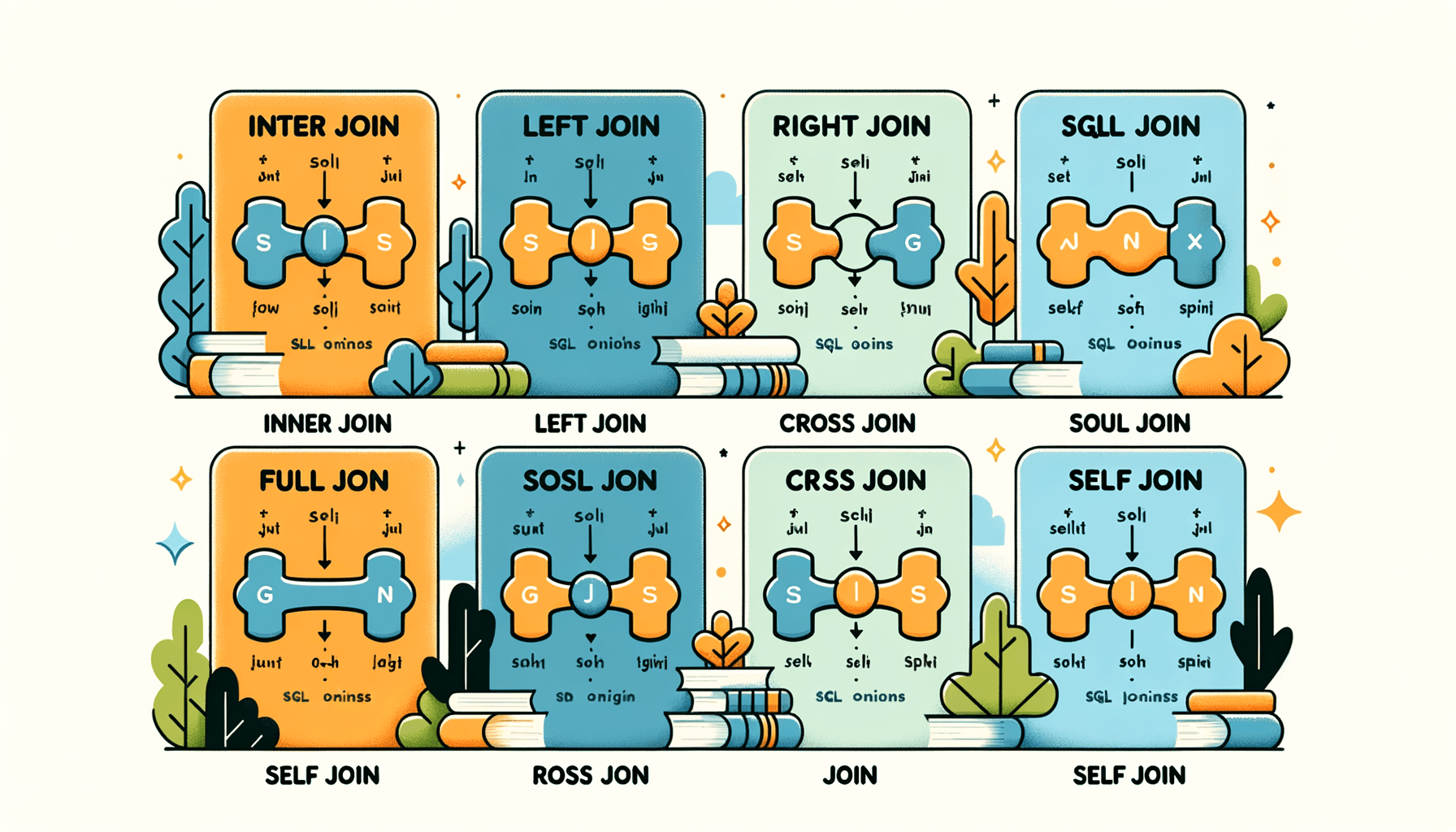A big variety of articles and resources

Mastering Data Management: The Ultimate SQL Training Guide
 Sia Author and Instructor
Learn SQL
Sia Author and Instructor
Learn SQL
14 minute read
Learning SQL is like getting a key to unlock the power of data. SQL, or Structured Query Language, is the language used to talk to databases. It helps you manage and use data in lots of different ways. Whether you're just starting out or looking to boost your skills, this guide will help you master SQL and become a data expert.
Key Takeaways
- Understand the basics of SQL and relational databases.
- Learn advanced SQL functions like UNION, MIN, and MAX.
- Discover how to optimize your SQL queries for better performance.
- Ensure data integrity and security with SQL constraints and transactions.
- Explore real-world applications of SQL in business and web development.
Foundations of SQL Training
Understanding Relational Databases
To start with SQL, you need to understand relational databases. These databases store data in tables, which are like grids with rows and columns. Each table has a unique key that identifies its rows. Relational databases are powerful because they allow you to link data from different tables using these keys.
Introduction to SQL Syntax
SQL, or Structured Query Language, is the language used to interact with relational databases. The basic commands include SELECT, INSERT, UPDATE, and DELETE. These commands let you retrieve, add, change, and remove data in your database. Learning SQL syntax is the first step to mastering data management.
Basic Data Types and Structures
In SQL, data types define the kind of data you can store in a table. Common data types include INT for numbers, VARCHAR for text, and DATE for dates. Understanding these basic data types helps you design tables that store your data efficiently.
Mastering these foundations is crucial for anyone looking to excel in SQL and data management. It sets the stage for more advanced topics and practical applications.
Advanced SQL Functions and Techniques
Mastering the UNION and UNION ALL Operators
In SQL, the UNION and UNION ALL operators are used to combine the results of two or more SELECT statements. While UNION removes duplicate records, UNION ALL includes all duplicates. Understanding the difference between these two can significantly impact query performance and result accuracy.
Effective Use of MIN and MAX Functions
The MIN and MAX functions are essential for finding the smallest and largest values in a dataset. These functions are particularly useful in data analysis and reporting. For example, you can use MIN to find the earliest date in a set of records or MAX to identify the highest sales figure.
Implementing Complex Joins
Joins are fundamental in SQL for combining data from multiple tables. Complex joins, such as INNER JOIN, LEFT JOIN, and RIGHT JOIN, allow for more sophisticated data retrieval. Mastering these joins enables you to handle intricate queries and improve data integrity.
Advanced SQL techniques are crucial for anyone looking to deepen their database management skills. Mastering these functions and techniques will not only make your queries more efficient but also enhance your ability to analyze and interpret data effectively.
Optimizing Query Performance
Indexing Strategies for Faster Queries
When it comes to speeding up your SQL queries, indexing is a game-changer. Indexes help the database find rows much faster than scanning the entire table. Think of an index like a book's table of contents; it helps you quickly locate the information you need. However, be cautious—too many indexes can slow down write operations.
Query Execution Plans
Understanding query execution plans is crucial for optimizing performance. These plans show how the database engine executes a query, step by step. By analyzing these plans, you can identify bottlenecks and make necessary adjustments. Use tools like EXPLAIN in MySQL or EXPLAIN ANALYZE in PostgreSQL to get detailed insights.
Optimizing Joins and Subqueries
Joins and subqueries can be performance killers if not used correctly. Always aim to use the most efficient join type for your needs. For example, INNER JOINs are generally faster than OUTER JOINs. Also, consider rewriting subqueries as joins or using temporary tables to store intermediate results. This can significantly enhance SQL skills and improve query performance.
Optimizing your SQL queries is not just about speed; it's about making your database more efficient and reliable. By focusing on these strategies, you can ensure that your database performs well under various conditions.
Data Integrity and Security
Ensuring Data Accuracy with Constraints
Maintaining data accuracy is crucial for any database system. Constraints are rules applied to database columns to ensure the validity of the data. Common types of constraints include:
- Primary Key: Ensures each record is unique.
- Foreign Key: Maintains referential integrity between tables.
- Unique: Guarantees all values in a column are different.
- Check: Validates that values meet a specific condition.
Using these constraints helps in maintaining data accuracy and consistency across the database.
Implementing Transactions
Transactions are essential for ensuring data integrity, especially in multi-user environments. A transaction is a sequence of operations performed as a single logical unit of work. The key properties of transactions are known as ACID (Atomicity, Consistency, Isolation, Durability):
- Atomicity: Ensures that all operations within the transaction are completed; if not, the transaction is aborted.
- Consistency: Guarantees that the database remains in a valid state before and after the transaction.
- Isolation: Ensures that transactions do not interfere with each other.
- Durability: Once a transaction is committed, it remains so, even in the event of a system failure.
SQL Injection Prevention
SQL injection is a common security vulnerability that allows attackers to interfere with the queries an application makes to its database. To prevent SQL injection, consider the following practices:
- Use Prepared Statements: These ensure that SQL code is separated from data inputs.
- Validate User Inputs: Always check and sanitize inputs from users.
- Limit Database Permissions: Only grant the necessary permissions to users and applications.
By following these practices, you can significantly reduce the risk of SQL injection attacks and protect your database from unauthorized access.
Ensuring data integrity and security is not just about protecting data but also about maintaining the trust and reliability of your database systems.
Database Schema Management
Designing Efficient Schemas
Creating an efficient database schema is crucial for optimal performance. A well-designed schema ensures that data is organized logically and can be accessed quickly. When designing schemas, I focus on understanding the relationships between different data entities and how they interact. This helps in structuring the database in a way that minimizes redundancy and maximizes efficiency.
Normalization and Denormalization
Normalization involves organizing data to reduce redundancy and improve data integrity. It typically includes dividing large tables into smaller, related tables. However, over-normalization can lead to complex queries and slower performance. In some cases, denormalization, which combines tables to reduce the number of joins, can be beneficial. Finding the right balance between normalization and denormalization is key to effective database management.
Schema Version Control
Managing changes to the database schema is essential for maintaining data integrity and consistency. Schema version control involves tracking and documenting changes to the database structure over time. This practice helps in coordinating updates and ensuring that all changes are tested and reviewed before implementation. Using tools like version control systems can streamline this process and provide a clear history of schema modifications.
Scalability and Integration
Handling Large Datasets
Managing large datasets efficiently is crucial for any database system. Effective indexing and partitioning strategies can significantly improve performance. Consider using horizontal and vertical partitioning to distribute data across multiple tables or databases. This approach not only enhances performance but also ensures data is more manageable.
Database Migrations
Database migrations involve transferring data from one system to another. This process can be complex, requiring careful planning and execution. Key steps include:
- Assessing the current database structure.
- Planning the migration strategy.
- Testing the migration process.
- Executing the migration.
- Validating the migrated data.
Integrating SQL with Other Technologies
SQL can be integrated with various technologies to enhance its functionality. For instance, combining SQL with Python or R can provide powerful data analysis capabilities. Additionally, integrating SQL with web technologies like PHP or Node.js allows for dynamic data-driven websites. This integration is essential for creating robust, scalable applications.
SQL for Data Analysis
Grouping and Aggregating Data
Grouping and aggregating data are essential skills for any data analyst. By using the GROUP BY clause, you can organize data into meaningful summaries. For example, you can group sales data by region to see which areas are performing best. Aggregating functions like SUM, AVG, and COUNT help in summarizing this grouped data.
Using Window Functions
Window functions allow you to perform calculations across a set of table rows related to the current row. Unlike aggregate functions, window functions do not cause rows to become grouped into a single output row. This makes them incredibly useful for running totals, moving averages, and ranking data. Mastering window functions can significantly enhance your data analysis capabilities.
Advanced Filtering Techniques
Advanced filtering techniques involve using complex conditions to refine your data queries. This can include using subqueries, HAVING clauses, and conditional logic. These techniques allow you to extract exactly the data you need, making your analysis more precise and insightful.
Understanding these advanced SQL techniques can transform your data analysis, making it more efficient and effective.
Real-World SQL Applications
Case Studies in Business Intelligence
In the realm of business intelligence, SQL is indispensable. It allows for the extraction, transformation, and loading (ETL) of data, which is crucial for generating insights. Mastering SQL can significantly enhance your ability to analyze business data and make informed decisions. For instance, many companies use SQL to track sales performance, customer behavior, and market trends.
SQL in Web Development
SQL plays a vital role in web development by managing the backend databases that store user information, content, and other critical data. Whether you're developing a small blog or a large e-commerce site, SQL helps in efficiently handling data operations. This guide emphasizes the importance of SQL in web development, showcasing its role in managing large datasets and dynamic websites.
Data Warehousing with SQL
Data warehousing involves collecting and managing data from various sources to provide meaningful business insights. SQL is the backbone of data warehousing, enabling the querying and analysis of large datasets. It offers practical learning through hands-on projects led by experienced instructors, making it accessible for learners at all levels.
SQL Training for Career Advancement
Certifications and Professional Development
Earning certifications can significantly boost your career. Top-rated SQL courses online for aspiring data professionals often include certifications that validate your skills. These certifications not only enhance your resume but also demonstrate your commitment to professional growth.
Building a SQL Portfolio
Creating a portfolio of your SQL projects is essential. This portfolio showcases your ability to solve real-world problems and highlights your expertise. Include projects that demonstrate your skills in data analysis, database management, and complex query writing.
Networking and Community Involvement
Engaging with the SQL community can open doors to new opportunities. Join forums, attend webinars, and participate in local meetups. Networking helps you stay updated with industry trends and can lead to job offers and collaborations.
Investing in your SQL skills is a strategic move for career advancement. By earning certifications, building a strong portfolio, and networking, you position yourself as a valuable asset in the data management field.
Tools and Resources for SQL Training
Popular SQL IDEs and Tools
When diving into SQL, having the right tools can make a world of difference. Popular Integrated Development Environments (IDEs) like SQL Server Management Studio (SSMS), MySQL Workbench, and Oracle SQL Developer offer robust features for writing and testing SQL queries. These tools provide a user-friendly interface and powerful debugging capabilities, making them essential for both beginners and advanced users.
Online Courses and Tutorials
For structured learning, online courses are invaluable. Platforms like Coursera, Udemy, and edX offer comprehensive SQL courses ranging from beginner to advanced levels. These courses often include hands-on projects and quizzes to reinforce learning. Engaging with community forums like Stack Overflow can also provide additional support and insights.
Books and Publications
Books remain a timeless resource for mastering SQL. Titles like "SQL for Dummies" and "Learning SQL" offer in-depth knowledge and practical examples. These books are excellent for those who prefer a more traditional approach to learning. Additionally, subscribing to SQL-related journals and blogs can keep you updated on the latest trends and best practices in the field.
Structured learning and hands-on projects are crucial for mastering SQL. Combining these resources will provide a well-rounded education and practical experience.
By leveraging these tools and resources, you can build a strong foundation in SQL and advance your skills effectively.
Leadership in Database Management
Leading Database Projects
In leading database projects, it's crucial to have a clear vision and a well-defined plan. Effective leadership involves not only technical expertise but also the ability to manage teams and resources efficiently. I always start by setting clear goals and expectations for the team. This helps in aligning everyone's efforts towards a common objective. Regular check-ins and updates ensure that the project stays on track and any issues are addressed promptly.
Team Collaboration and Communication
Team collaboration and communication are the backbones of any successful project. I emphasize the importance of open communication channels within the team. Tools like Slack or Microsoft Teams can be very useful for this purpose. Additionally, regular team meetings and brainstorming sessions can foster a collaborative environment where everyone feels valued and heard. This not only boosts morale but also leads to more innovative solutions.
Strategic Planning for Database Systems
Strategic planning for database systems involves long-term thinking and careful consideration of future needs. I focus on scalability, security, and performance when planning database systems. It's essential to anticipate future growth and ensure that the database can handle increased loads without compromising performance. Security measures should be robust to protect sensitive data from breaches. Lastly, regular performance reviews and optimizations can help in maintaining the efficiency of the database system.
In my experience, the key to successful database management lies in a balanced approach that combines technical skills with strong leadership and strategic planning.
Effective leadership in database management is key to any successful tech project. Our courses are designed to help you master these skills, whether you're just starting out or looking to advance your career. Visit our website to explore our offerings and start your journey today!
Conclusion
Mastering SQL is more than just learning a programming language; it's about understanding how to manage and manipulate data effectively. This guide has provided you with the essential tools and knowledge to navigate the complexities of SQL. By engaging in hands-on projects and real-world scenarios, you have gained practical experience that will be invaluable in your career. Remember, the key to mastering SQL is continuous practice and staying updated with the latest advancements. With dedication and the right resources, you can become proficient in SQL and open up new opportunities in the field of data management.
Frequently Asked Questions
What is SQL and why is it important?
SQL stands for Structured Query Language. It's used to manage and manipulate databases. SQL is important because it allows you to access and work with data efficiently.
Do I need a background in programming to learn SQL?
No, you don't need a programming background to start learning SQL. It's designed to be straightforward and easy to understand, even for beginners.
What are relational databases?
Relational databases store data in tables that are linked to each other. This structure makes it easy to organize and retrieve data.
How long does it take to learn SQL?
The time it takes to learn SQL varies. With regular practice, you can get a good grasp of the basics in a few weeks. Mastering advanced topics might take a few months.
What are some common SQL commands?
Some common SQL commands include SELECT, INSERT, UPDATE, DELETE, and CREATE. These commands help you perform basic database operations.
Can SQL be used for data analysis?
Yes, SQL is widely used for data analysis. It helps you query and manipulate data, making it easier to generate insights and reports.
What is a JOIN in SQL?
A JOIN in SQL is used to combine rows from two or more tables based on a related column. This is useful for retrieving related data from multiple tables.
How can I practice SQL?
You can practice SQL using online platforms, tutorials, and sample databases. Many websites offer interactive SQL exercises to help you improve your skills.







